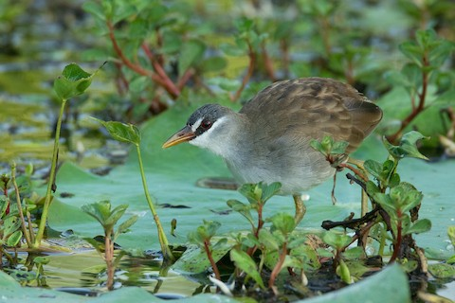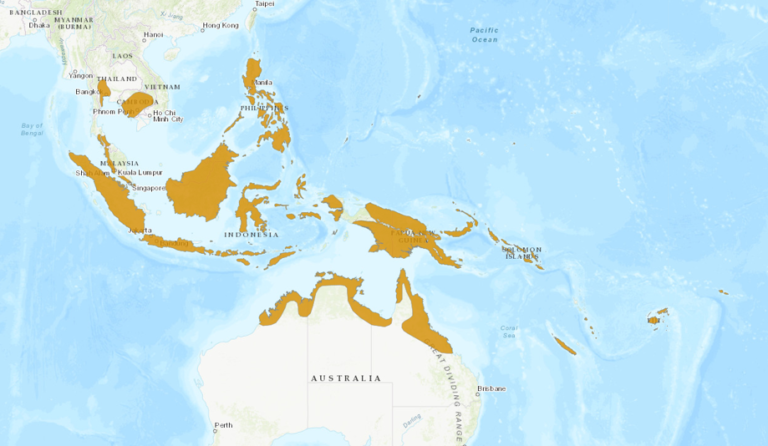Birdfinding.info ⇒ Common in several parts of its large range, and generally bolder and more observable than most small rails. It can be found in wetlands within several major metropolitan areas, including Bangkok (e.g., Mueang Boran and Lat Krabang), Singapore (e.g., Lorong Talus and Kranji), Manila, Jakarta, and Cairns.
White-browed Crake
Poliolimnas cinereus
Tropical wetlands from Southeast Asia to the mid-Pacific.
Widespread throughout Indonesia, the Philippines, New Guinea, the Bismarck Archipelago, and the Solomon Islands, and more patchily northwest into Southeast Asia, north into Micronesia, south to the humid tropical zone of Australia, and east to New Caledonia, Vanuatu, Fiji, and Samoa.
In Southeast Asia, widespread in lowlands and foothill wetlands from northern Thailand and northern Vietnam south to Singapore. Starting around 2016, it has been reported several times in central and northern Myanmar, which suggest that it is either colonizing that area or went unnoticed.
In Micronesia, resident on Palau, Truk, Pohnpei, and formerly on Japan’s Iwo Islands and Guam, where extirpated around the 1910s and 1970s, respectively.
In Australia, occurs in lowlands, mostly along the northern coast, from Broome (Western Australia) east to Mackay (Queensland).
Prone to long-distance wandering, it has been recorded as a vagrant to Assam, the Andaman Islands (possibly resident), southern provinces of China (Yunnan, Guangxi, and Hong Kong), Taiwan (nearly annual), and Bikini Atoll.
Identification
A distinctive small gray-and-brown rail with a striking facial pattern: a bold black eyestripe bordered by two white stripes, a long one from chin to ear and a much shorter white brow.
Largely gray on head, neck, and underparts. Tones generally progress from darker to lighter, starting from the slaty crown and becoming whitish on the belly.
Back and wing feathers have pale-brown edges and darker centers. Tones vary widely on a spectrum from warm-brown, buffy, and tan, to gray-brown. The contrast between darker and lighter shades also varies widely.
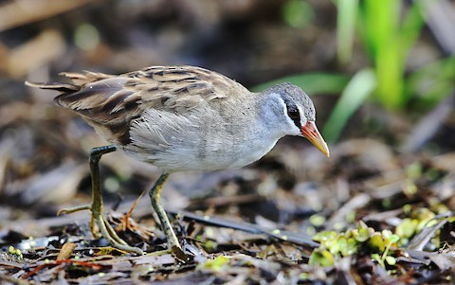
White-browed Crake. (Tyto Wetlands, Hinchinbrook, Queensland, Australia; November 5, 2016.) © Tony Ashton

White-browed Crake. (Long Valley, Hong Kong; September 27, 2014.) © Martin Hale
Its bill is usually some shade of orange. Sometimes brightly colored, when it is often closer to scarlet around the base, becoming paler and duller toward the tip. Sometimes dull with blackish or olive tones.
The eyes are typically deep-red with red orbital skin, but can also be all-dark.
Legs are yellow, and can have either a greenish or an orange tint.
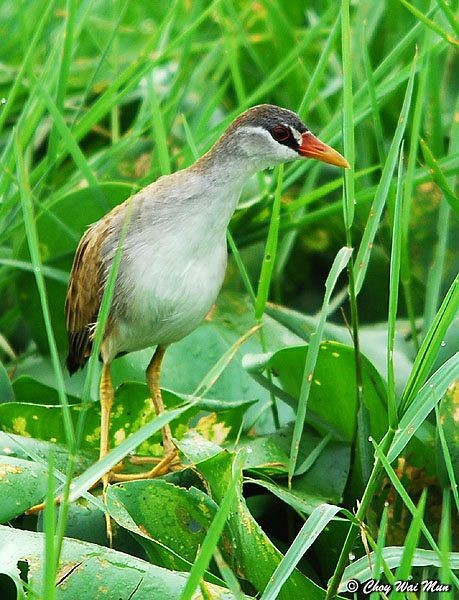
White-browed Crake, showing warm-brown or buffy upperparts. (Pulau Burung, Penang, Malaysia; January 2, 2010.) © Choy Wai Mun
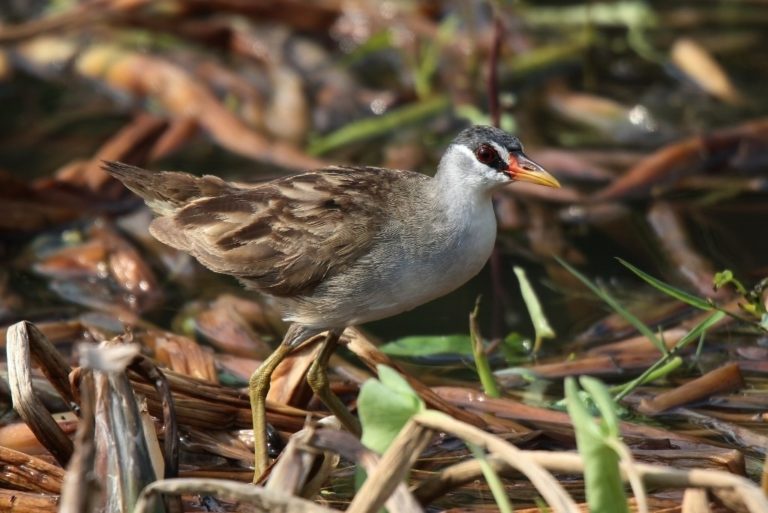
White-browed Crake. (Klungkung Regency, Bali, Indonesia; May 7, 2016.) © oldman19510
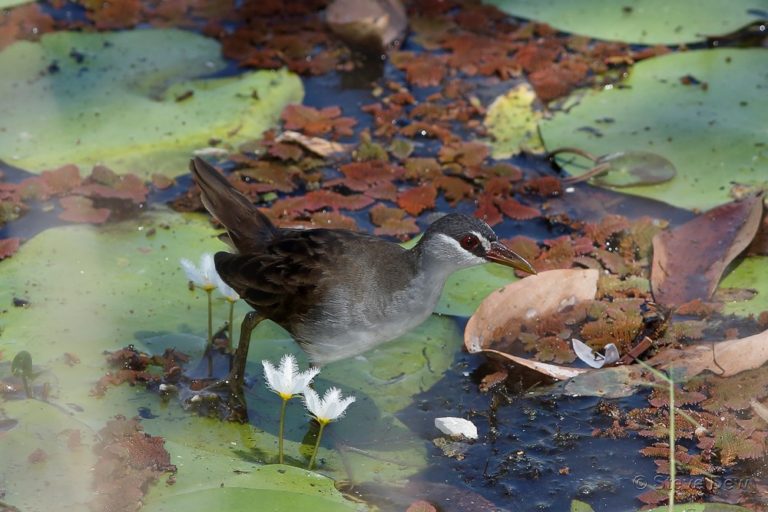
White-browed Crake. (Hinchinbrook, Queensland, Australia; November 14, 2019.) © aussiecreature

White-browed Crake, showing its slaty-gray crown. (Nonthaburi, Thailand; February 7, 2017.) © Ayuwat Jearwattanakanok

White-browed Crake, cloase-up showing bold facial pattern, reddish base of orange bill, and deep-red iris and orbital skin. (Moni ricefields, Flores, Indonesia; January 23, 2005.) © Mark Schellekens
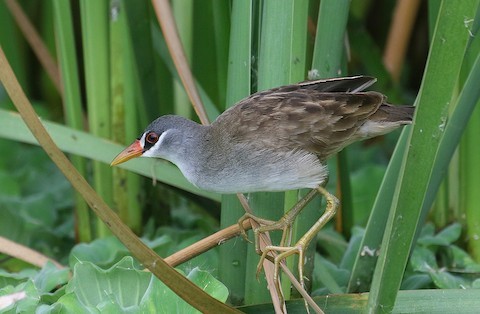
White-browed Crake. (Lat Krabang, Thailand; June 6, 2019.) © Peter Ericsson
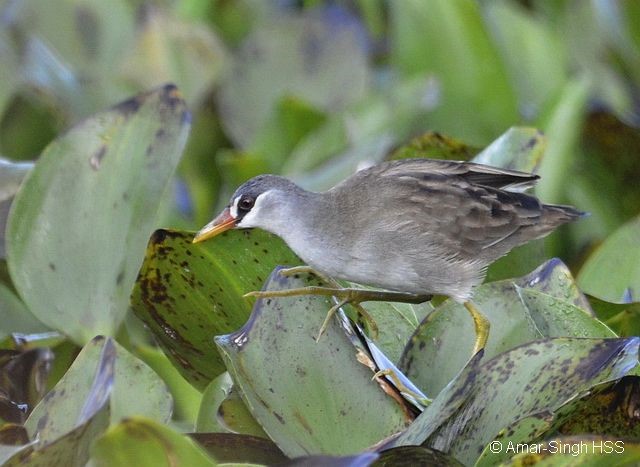
White-browed Crake with mostly grayish-brown upperparts and all-dark eyes. (Kota Bahru, Perak, Malaysia; January 31, 2013.) © Amar-Singh HSS

White-browed Crake with dull-brown upperparts lacking contrast between feather edges and centers. (Nonthaburi, Thailand; February 7, 2017.) © Ayuwat Jearwattanakanok
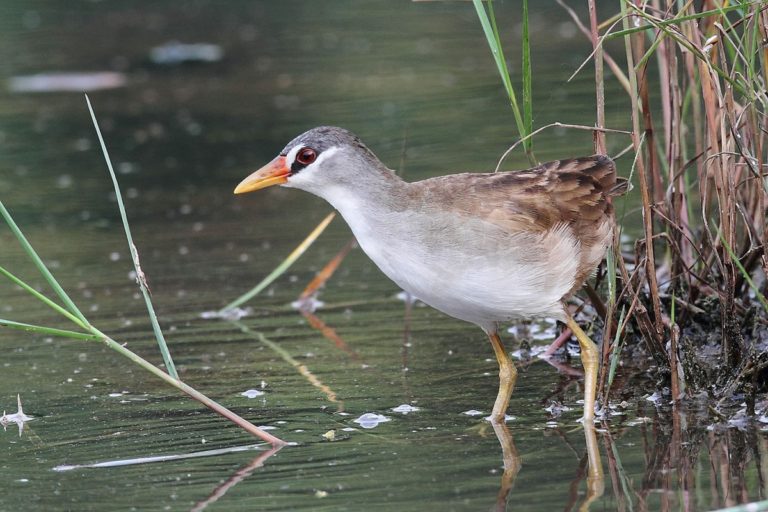
White-browed Crake. (Lorong Halus, Singapore; June 11, 2011.) © Myron Tay
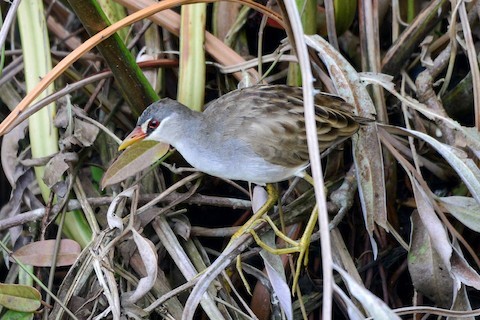
White-browed Crake. (Batu Kawan, Penang, Malaysia; February 18, 2020.) © Harn Sheng Khor

White-browed Crake, showing warm-brown upperparts. (Louisa Creek, Townsville, Queensland, Australia; October 27, 2018.) © Len and Chris Ezzy
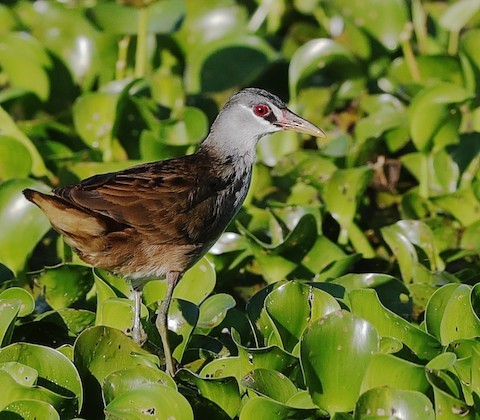
White-browed Crake with exceptionally rusty upperparts. (Ross River Bush Gardens, Townsville, Queensland, Australia; August 14, 2018.) © Tony Ashton
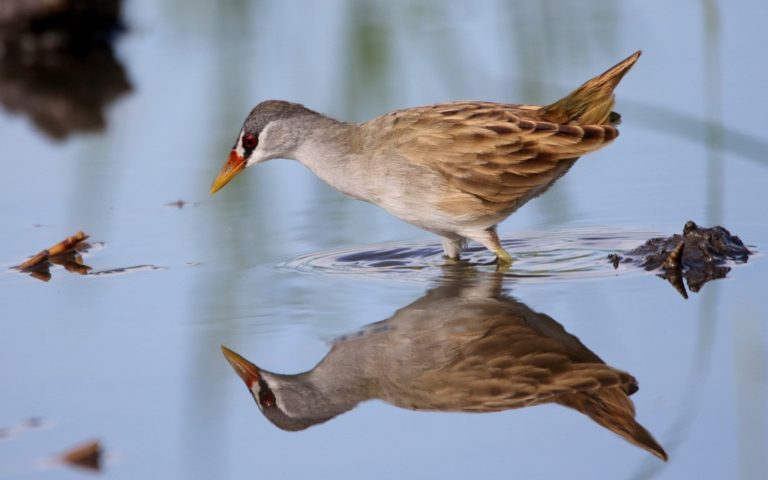
White-browed Crake. (East Nusa Tenggara, Indonesia; November 28, 2018.) © Yovie Jehabut
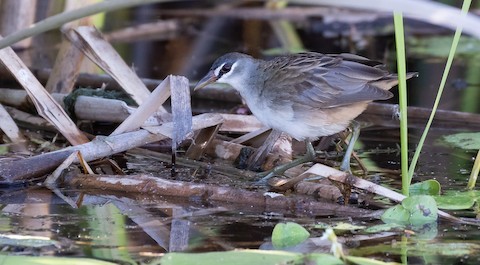
White-browed Crake with mostly gray plumage and buffy undertail coverts. (Lily Creek Lagoon, Kununurra, Western Australia; August 10, 2018.) © Barry Deacon
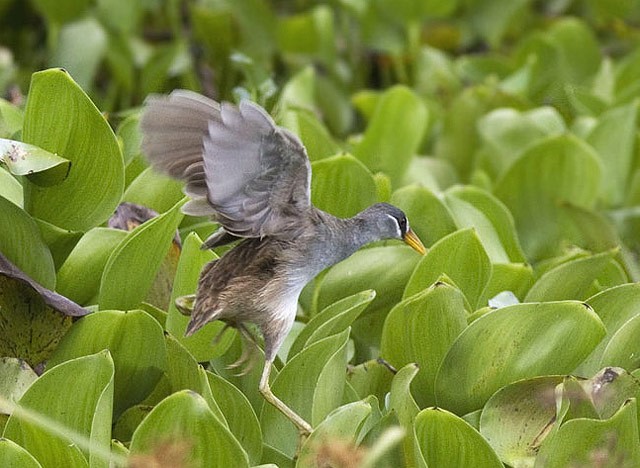
White-browed Crake, showing pale-gray underwing. (Candaba, Pampanga, Philippines; March 17, 2007.) © Tina Mallari

White-browed Crake, showing pale-gray underwing. (Nonthaburi, Thailand; February 7, 2017.) © Ayuwat Jearwattanakanok
Immatures are mostly buffy and brown, and could be mistaken for other species, but can be recognized by the orange bill and usually a detectable but muted version of the adult’s distinctive facial pattern.
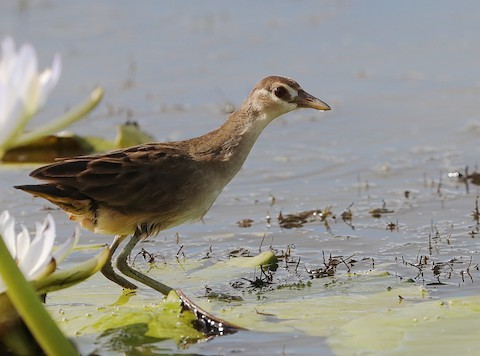
White-browed Crake, immature. (Townsville Town Common Conservation Park, Townsville, Queensland, Australia; December 29, 2017.) © Tony Ashton

White-browed Crake, immature with bright orange-buffy plumage, showing muted facial pattern. (Byram Estate, Penang, Malaysia; March 21, 2009.) © Choy Wai Mun

White-browed Crake, subadult. (Lily Creek Lagoon, Kununurra, Western Australia; June 11, 2017.) © Vicki Stokes
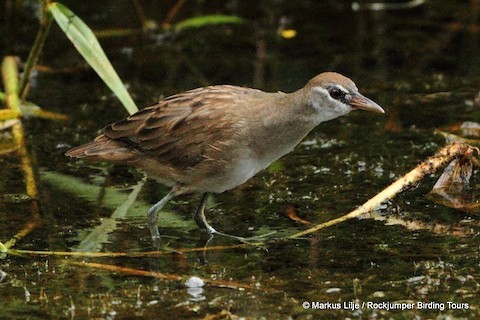
White-browed Crake, subadult with a warm-brown crown and dark bill. (Kimbe Bay, West New Britain, Papua New Guinea; August 31, 2013.) © Markus Lilje
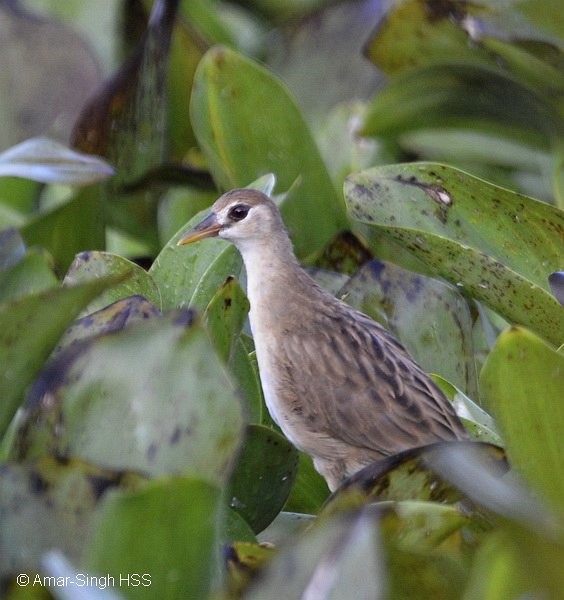
White-browed Crake, immature with grayish plumage, showing muted facial patterne. (Kota Bahru, Perak, Malaysia; January 26, 2013.) © Amar-Singh HSS

White-browed Crake, immature with buffy plumage. (Tambun, Perak, Malaysia; March 31, 2014.) © Amar-Singh HSS
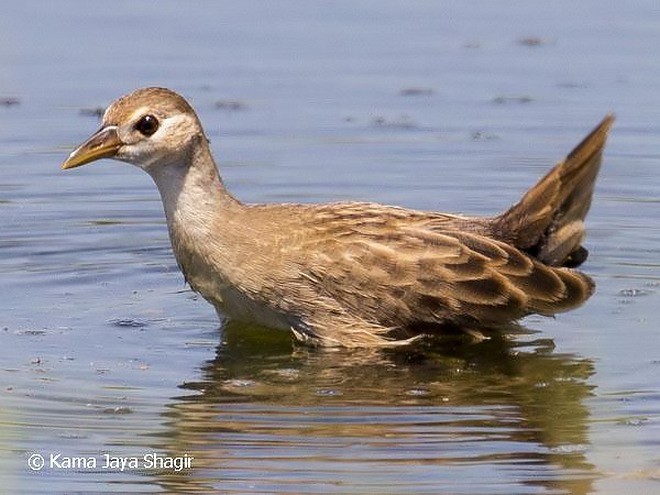
White-browed Crake, immature with buffy plumage, showing muted facial pattern. (Parangloe Village, Tamalanrea, South Sulawesi, Indonesia; August 14, 2016.) © Kama Jaya Shagir

White-browed Crake, immature with buffy plumage. (Batu Kawan, Penang, Malaysia; May 5, 2019.) © Yen Loong Lean
Notes
Monotypic species.
References
BirdLife International. 2016. Amaurornis cinerea. The IUCN Red List of Threatened Species 2016: e.T22692723A93366932. https://dx.doi.org/10.2305/IUCN.UK.2016-3.RLTS.T22692723A93366932.en. (Accessed September 28, 2020.)
Brazil, M. 2009. Birds of East Asia. Princeton University Press.
eBird. 2020. eBird: An online database of bird distribution and abundance. Cornell Lab of Ornithology, Ithaca, N.Y. http://www.ebird.org. (Accessed September 28, 2020.)
Pratt, H.D., P.L. Bruner, and D.G. Berrett. 1987. A Field Guide to the Birds of Hawaii and the Tropical Pacific. Princeton University Press.
Ripley, S.D. 1977. Rails of the World: A Monograph of the Family Rallidae. David R. Godine, Publisher, Boston.
Robson, C. 2002. Birds of Thailand. Princeton University Press.
Taylor, B., and B. van Perlo. 1998. Rails: A Guide to the Rails, Crakes, Gallinules, and Coots of the World. Yale University Press.
Xeno-Canto. 2020. White-browed Crake – Porzana cinerea. https://www.xeno-canto.org/species/Porzana-cinerea. (Accessed September 28, 2020.)
